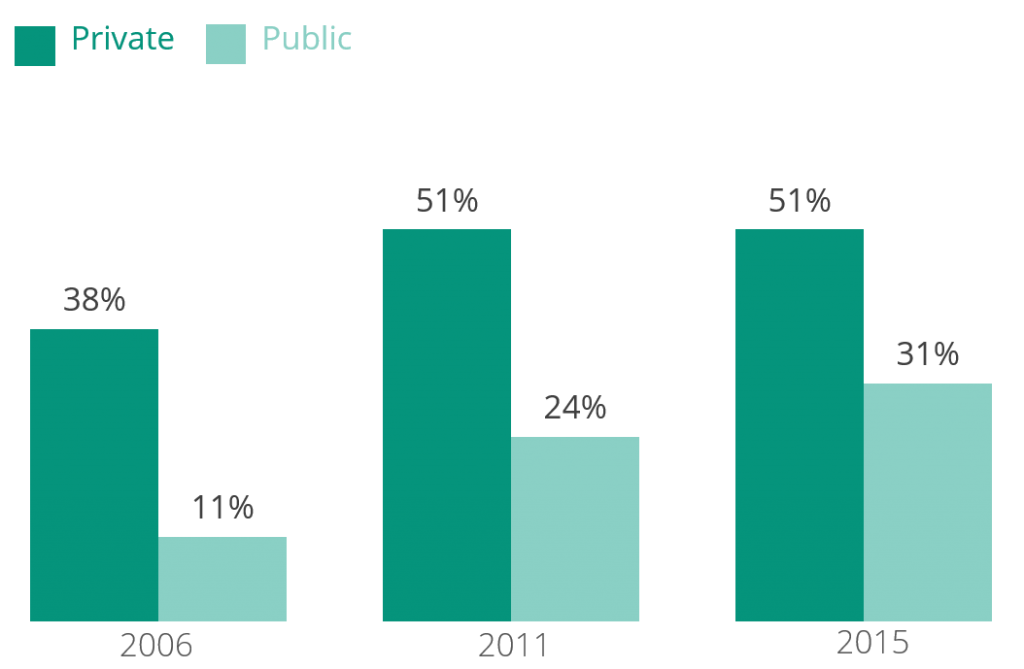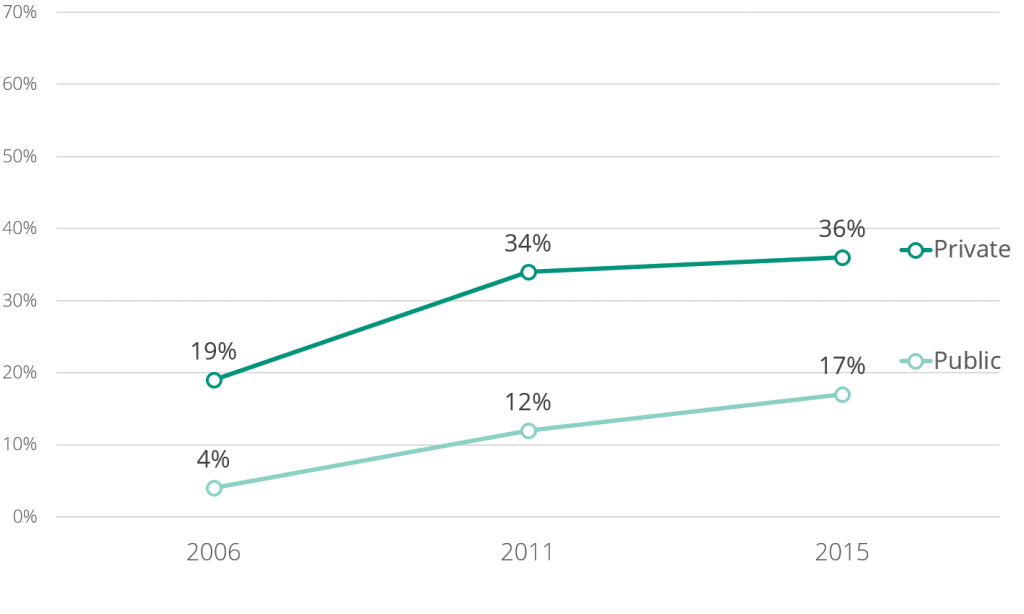LSSSE Annual Results: Large Tuition Increases at Public Law Schools
This is the second installment in a series of posts centered around data from the 2015 LSSSE Survey administration and the 2015 Annual Report, which provides a retrospective glimpse into law student debt trends over a 10-year period, 2006 to 2015, with 2011 as a midpoint. This post discusses student debt trends based on institutional sector—i.e. whether the law school is public or private.
In each of the three survey years we studied—2006, 2011 and 2015—higher proportions of respondents attending private law schools expected debt above $120,000, compared to their peers at public schools. Throughout higher education, private school tuition tends to be higher than those at public schools—a reflection of the relative absence of public subsidies to private schools. In both realms, the proportions of respondents who expected debt above $120,000 increased between 2006 and 2015.
In 2006, 38% of private school respondents expected to owe more than $100,000; in 2011 and 2015, that proportion exceeded 50%. Tuition and, therefore, debt is growing dramatically at public college and universities, due in large part to declines in the aforementioned state subsidies. While the high-debt expectations were lower among respondents attending public law schools, the increases over the survey years were more dramatic. In 2006, only 11% of LSSSE respondents expected debt of more than $100,000; by 2015, this proportion had almost tripled to 31%. [i]
The increases were even more compelling among respondents who expected more than $120,000 in debt. In 2006, only 4% of public school respondents expected debt at this level; by 2015, that proportion had more than quadrupled to 17%. The same proportions almost doubled among private law school respondents—19% in 2006 and 36% in 2015. [ii]
Focusing once again on the subset of respondents who expected to owe more than $100,000, in 2015 a whopping 71% of those respondents who attended private schools expected to owe more than $120,000. Fifty-six percent of this high-debt subset at public schools expected to owe more than $120,000 in 2015—the first year this proportion crossed the 50% threshold.
[i]. Proportion of respondents who expected to owe more than $100k

[ii]. Proportion of respondents who expected to owe more than $120K

LSSSE Annual Results: Ten Years of (Ever-rising) Law Student Debt
This is the first in a series of posts centered around data from the 2015 LSSSE Survey administration and the 2015 Annual Report, which provides a retrospective glimpse into law student debt trends over a 10-year period, using survey years 2006 and 2015 as bookends. Survey year 2011 will be used as a midpoint in much of the analyses—2011 is noteworthy because a record number of students—157,298—enrolled in U.S. law schools that year. This post discusses the increase in law student debt over the 10-year period.
The vast majority of law students— almost 90%, according to LSSSE Survey data and estimates by the American Bar Association—rely on student loans to finance their education. The typical law school graduate is part of a relatively rarefied group of debtors with student loan balances approaching, if not exceeding $100,000. In 2012, the average debt for graduates of private law schools was $127,000; $88,000 for public law school graduates. These amounts represented inflation-adjusted increases of one-quarter and one-third respectively in just seven years.
The LSSSE Survey asks respondents the following question:
“How much educational debt from attending law school do you expect to have upon your graduation?”
In order to account for the inherent imprecision of speculating about the future, the response options appearing on the survey are presented mostly as ranges in $20,000 intervals, with two outer options:
- $0
- $1- $20,000
- $20,001 – $40,000
- $40,001 – $60,000
- $60,001 – $80,000
- $80,001 – $100,000
- $100,001 – $120,000
- More than $120,000
For much of the analyses in this series of posts, the six intermediate ranges are compressed into three $40,000 ranges, with the outer options remaining the same:
- $0
- $1- $40,000
- $40,001 – $80,000
- $80,001 – $120,000
- More than $120,000
Unsurprisingly, over the 10-year timeframe, increasing proportions of LSSSE respondents reported expecting high law school debt. In 2006, 32% of respondents expected to incur more than $100,000 in debt during their law school matriculation. By 2011, that proportion had increased to 44%, a level at which it remained in 2015. The differences in expected debt were particularly acute at the highest level—more than $120,000. Roughly 30% of respondents in both 2011 and 2015 expected debt above $120,000, compared to 16% in 2006.
An analysis of the subgroups of “high-debt” respondents really highlights the prevailing trends. We measured the proportional split between respondents who expected to owe $100,001-$120,000 and those who expected to owe more than $120,000. In 2006, 51% of respondents in this high-debt subgroup expected to owe more than $120,000 (leaving 49% expecting to owe $100,001-$120,000). By 2015, 67% of this high-debt subgroup expected to owe more than $120,000.


